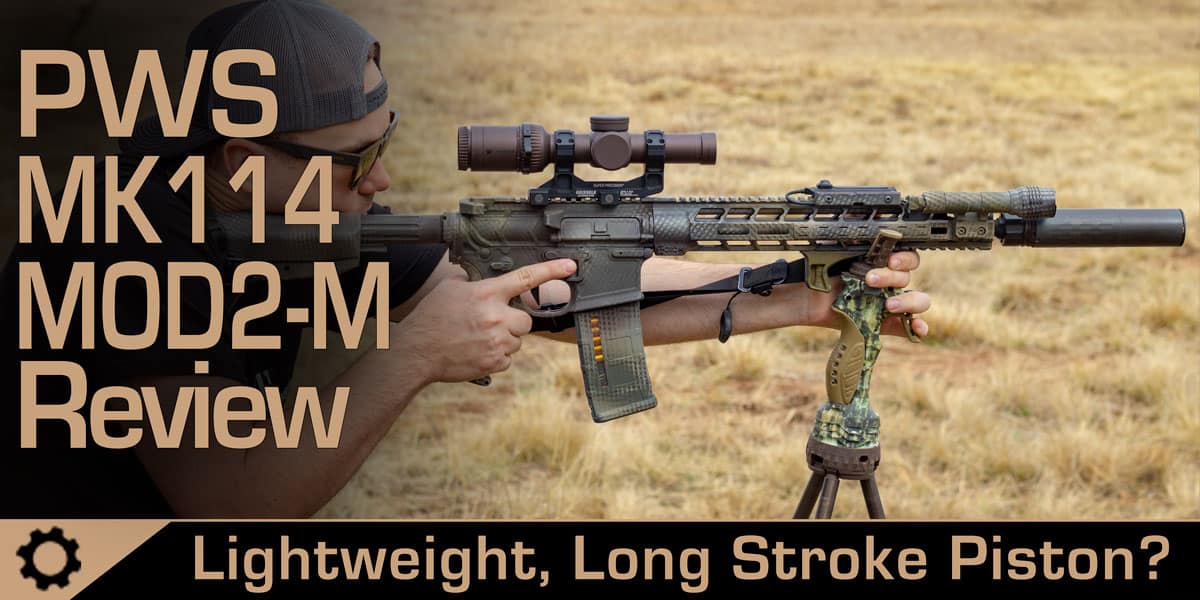 My PWS MK114 MOD2-M in .223 Wylde isn’t the first Primary Weapons System rifle I purchased. Last year my hog hunting addiction got me looking for a new, more lethal, hunting rifle. My quest put me on track to find an AR-10 chambered in .308 WIN. My requirement to easily and efficiently shoot suppressed and unsuppressed complicated things. AR-10 rifles chambered in .308 are notorious for being gassy, and they can be finicky when suppressed. After a ton of research, my findings led me to buy a Primary Weapons Systems (PWS) MK216 MOD 1-M.
My PWS MK114 MOD2-M in .223 Wylde isn’t the first Primary Weapons System rifle I purchased. Last year my hog hunting addiction got me looking for a new, more lethal, hunting rifle. My quest put me on track to find an AR-10 chambered in .308 WIN. My requirement to easily and efficiently shoot suppressed and unsuppressed complicated things. AR-10 rifles chambered in .308 are notorious for being gassy, and they can be finicky when suppressed. After a ton of research, my findings led me to buy a Primary Weapons Systems (PWS) MK216 MOD 1-M.
My new PWS .308 needed an optic so a month later I slapped a Vortex Viper PST Gen II 3-15×44 in a DLOC Mount on it. Then I topped it off with a NiteSite Night Vision device. That night Pro Staffer Jared Hilton and I put down 33 hogs as a 2 man team. I fell officially in love with the MK216 and PWS. So much so, that before the week’s end I ordered my second Primary Weapons Systems rifle. That purchase of the PWS MK114 MOD2-M in .223 Wylde brings us full circle, back to the point of this review. Interested in my thoughts on the MK216? Stay tuned for a future story!
Who Is Primary Weapons Systems?
 If you are not familiar with Primary Weapons Systems, you probably should be. PWS launched back in 2005 as AK Concepts and officially became Primary Weapons Systems in 2008. Applying their knowledge of the AK platform to the AR-15 rifle, they started selling their first long stroke piston operated AR’s in 2009.
If you are not familiar with Primary Weapons Systems, you probably should be. PWS launched back in 2005 as AK Concepts and officially became Primary Weapons Systems in 2008. Applying their knowledge of the AK platform to the AR-15 rifle, they started selling their first long stroke piston operated AR’s in 2009.
Basically, the idea to combine the versatility and accuracy of the AR platform with the reliability of the AK platform became the primary focus. Well, just take a look at their history over the last 10 years and you will see their overwhelmingly successes. I don’t want to spend a lot of time explaining their history and evolution over the last decade, that information is easy enough to find. But I thought it important to let you know that this is not some gimmicky concept by a company that is here today and gone tomorrow.
The Long Stroke Piston System vs. Short Stroke
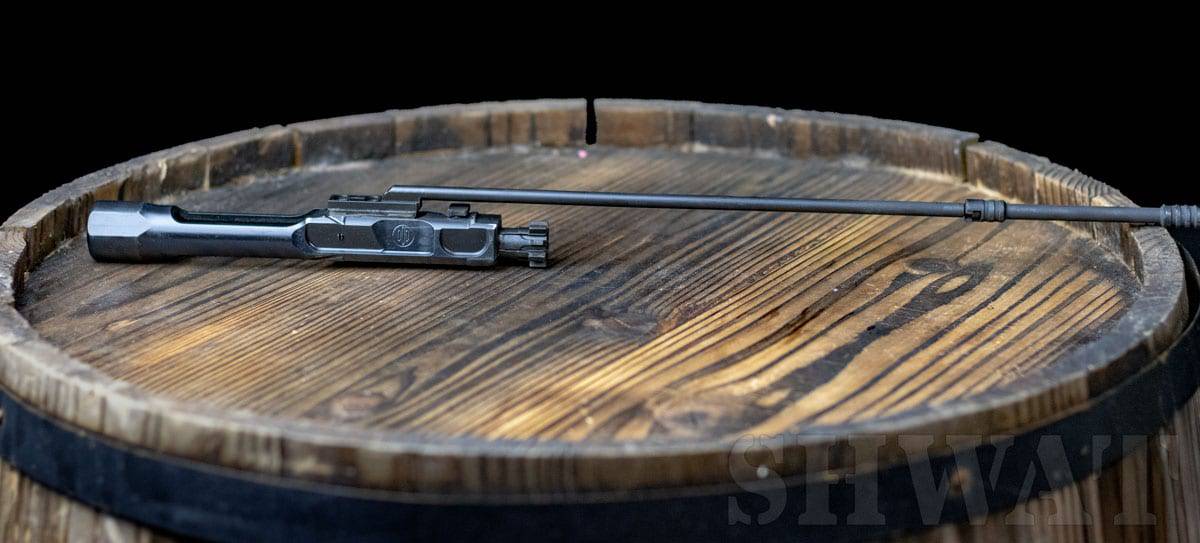 If you want to start a fight on the Internet, all you need to do is go on a gun forum and ask, “Piston vs. DI gun?” The answers are endless and in the end it really does just depend on your priorities and preferences. I’ll leave that off the table for today. What is important, however, are the differences between short stroke and long stroke piston systems, and why I choose the latter.
If you want to start a fight on the Internet, all you need to do is go on a gun forum and ask, “Piston vs. DI gun?” The answers are endless and in the end it really does just depend on your priorities and preferences. I’ll leave that off the table for today. What is important, however, are the differences between short stroke and long stroke piston systems, and why I choose the latter.
In a short stroke piston system, gas enters the gas block, which holds a captured rod. That rod is blown back, slapping the top of the bolt carrier and then returning. This is a very reliable system with a lot of benefits. Just take a look at LWRCI or HK for confirmation on that.
The downside to a short stroke system is it typically requires more parts, delivers a sharper recoil impulse, and is susceptible to carrier tilt. Because the operating rod slaps the top of the bolt carrier, it tends to push the rear of the bolt carrier downward. This in turn causes faster wear on the rear of the BCG and bottom of the receiver extension. Short version – things wear out faster.
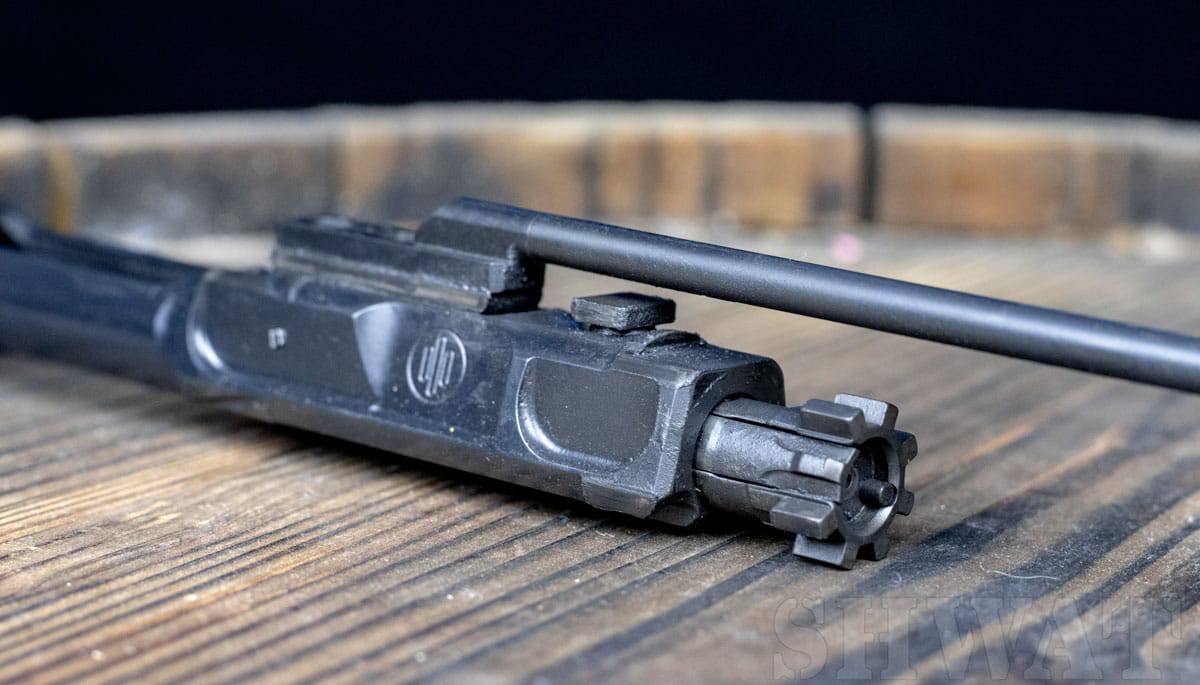
PWS Long Stroke System
The PWS long stroke system on my MOD2-M addresses these issues. The operating rod is attached to the bolt carrier group and it runs down a piston sleeve to where the front of the rod mates up with the gas block. When the weapon is fired gas enters the gas block and hits the piston head, pushing the whole system rearwards. Because the operating rod is attached to the bolt carrier, the whole system pushes towards the rear without carrier tilt.
The sleeve that the operating rod rides in helps this as well by not allowing the system to tilt, but it also protects the piston and operating rod from debris and the elements. Along the bottom portion of the sleeve there are multiple large gas ports that vent off gases gradually as the piston travels rearward. This causes the recoil impulse to be very smooth, feeling more like a push than a slap.
Suppressing Made Easy
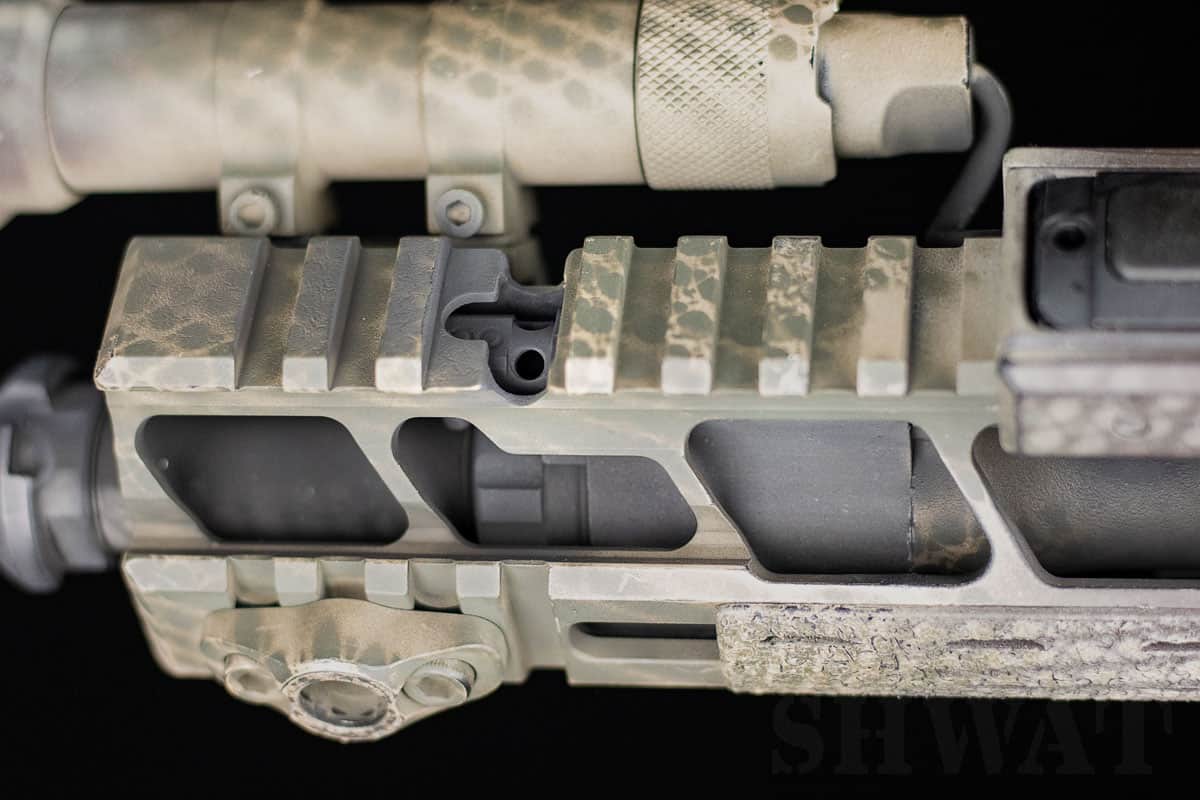 Let’s face it, it’s 2019 and you should have a suppressor by now, but they do tend to cause a few issues. Increased gas pressure, gas blowback, and cleaning become nightmares. Retrofitting an adjustable gas block can help with the first two issues, but it doesn’t help your cause when it comes to cleaning a suppressed direct impingement rifle. PWS made this super simple on the MOD2-M. There is a cutout on the rail that gives you access to the three position adjustable gas block.
Let’s face it, it’s 2019 and you should have a suppressor by now, but they do tend to cause a few issues. Increased gas pressure, gas blowback, and cleaning become nightmares. Retrofitting an adjustable gas block can help with the first two issues, but it doesn’t help your cause when it comes to cleaning a suppressed direct impingement rifle. PWS made this super simple on the MOD2-M. There is a cutout on the rail that gives you access to the three position adjustable gas block.
You will want to try all three to see what works the best for your individual setup. As a general rule, position one is used for unsuppressed fire. Position two is used for suppressed fire with a low blowback can while position three is for suppressed fire with a high blowback can. This easy to use and access system makes switching between suppressed and unsuppressed fire easy.
On top of that, you can also to tune for maximum reliability and preferred recoil impulse. The long stroke piston system doesn’t blow carbon and hot gasses back into the bolt carrier, letting the system to run cooler and cleaner. The biggest benefit to me is that cleaning becomes just a simple wipe down and not a carbon scraping torture fest.
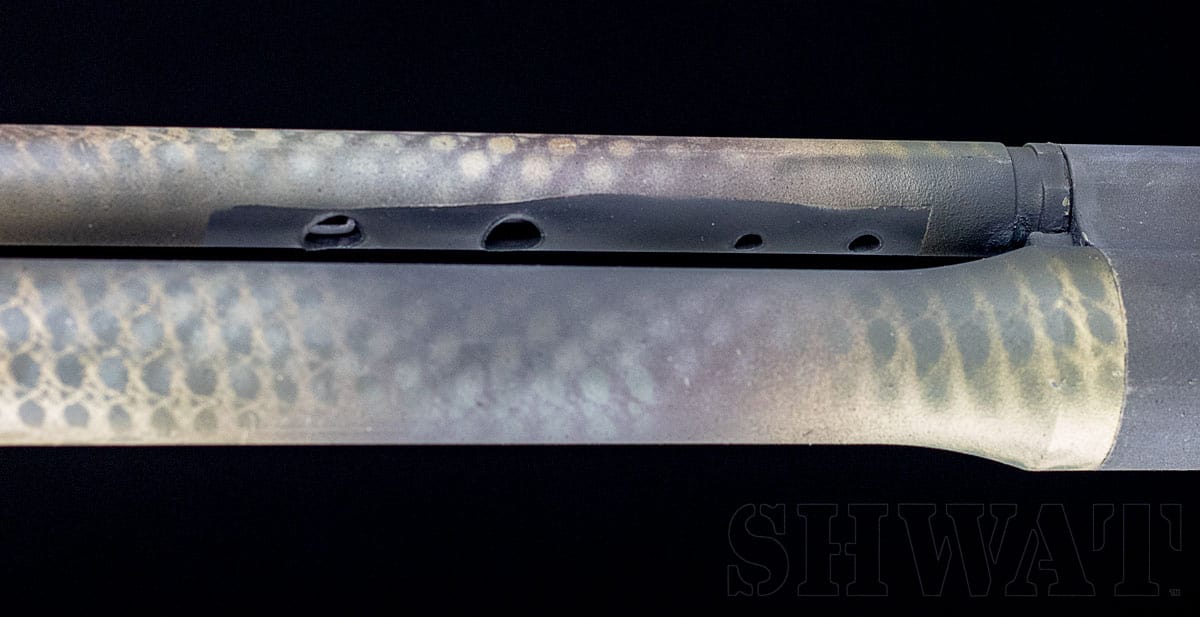 Fully Stocked
Fully Stocked
The PWS MK114 MOD2-M is well balanced and handles like a dream. One of the knocks on piston driven rifles is that they can be kind of portly. That is not the case with this rifle. It comes in at only 6 pounds 7 ounces. It is feature rich, straight out of the box, with a full length free float PicLok handguard, ambi mag release, and ambi bolt release. If you take a look at any of my personal AR builds you will notice a theme: BCM Gunfighter Stock, BCM Pistol Grip, Radian Raptor Charging Handle, and Radian Talon Ambi-Safety. The MOD2-M comes standard with that equipment, a huge win for me.
PWS did away with the forward assist on the MOD2-M. Now, I understand the debate around whether or not a forward assist is needed and both sides have valid points. In this case, the reason I don’t think it is an issue is because PWS is piston driven. Which means, the bolt carrier is going to get less gunked up than a DI gun, and the lack of gas rings allows the bolt to fully close with much less pressure than a gas operated BCG needs. If this is a hot button for you consider a PWS model with a forward assist. I’m just staying I haven’t missed it.
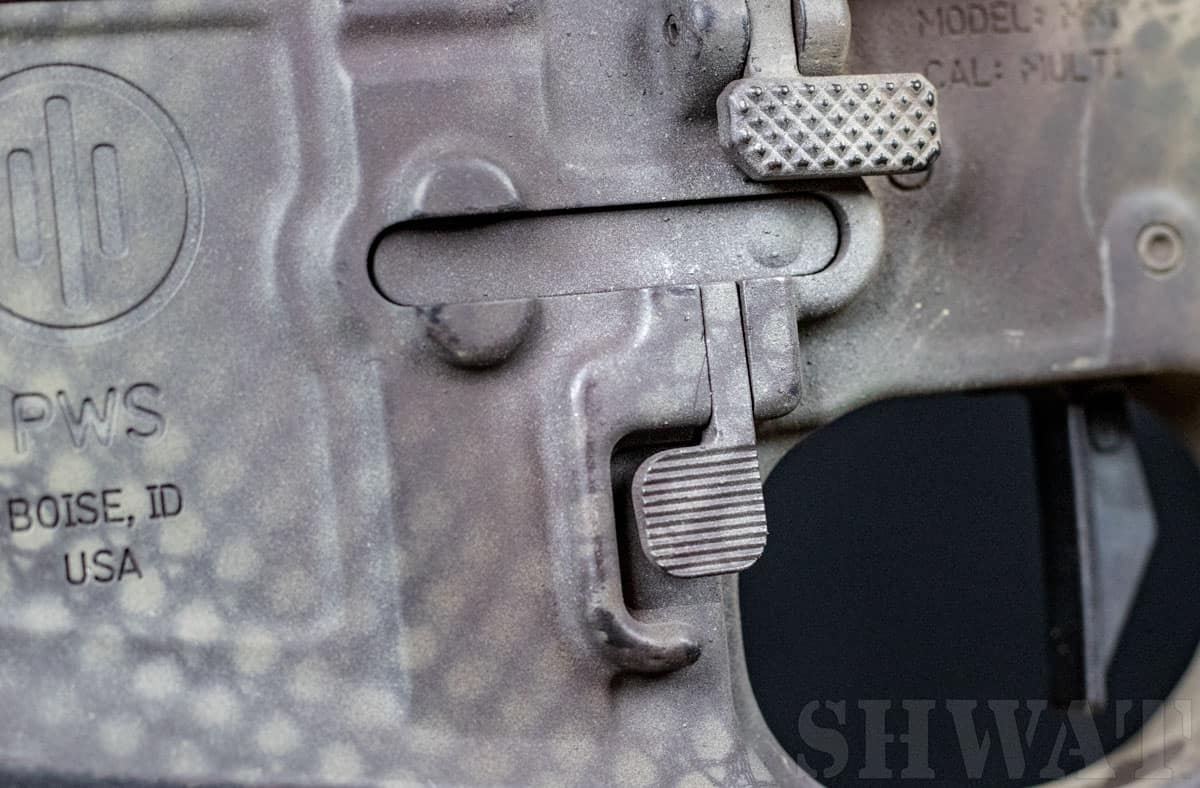
Ambi for me!
PWS MK114 MOD2-M Accuracy
I’m not going to lie to you. One of my initial concerns, “How accurate is this rifle going to be with its long stroke piston system?” I want it all. Features, reliability, ease of suppression, recoil impulse, light weight, aesthetics, and accuracy. I checked so many boxes I just knew this is where the trade off would happen, so I did some accuracy testing. Here are my results.
3 Shot Groups at 100 Yards:
- IMI M855 62gr – 3.25 in.
- American Eagle 55gr FMJ – 2.00 in.
- Norma Tac 223 55gr FMJ – 1.375 in.
- Frontier 5.56 M193 55gr – 1.125 in.
- Fiocchi 55gr FMJ BT- 1.50 in.
- Hornady Black 75gr BTHP – 0.75 in.
- Sig Sauer 40gr Varmint and Predator – 0.50 in.
Are you kidding me? It might be even more accurate than these results show. I used a Vortex Razor 1-6×24 Gen II-E, shooting off of a Vertx Range Bag with a sandbag under the stock in a 10 mph crosswind. What I found most impressive? The fact that it stabilized bullets from 40gr to 75gr and seemed to really like everything except the M855. The very next day I took out a prairie dog at 349 yards with this setup. I owned the long shot of the day till Robert, my brother-in-law, bagged one at 512 yards with a .224 Valkyrie. Can’t win them all I guess.
MK114 MOD2-M in .223 Wylde Conclusions
Do I consider my purchase of the MK114 MOD2-M money well spent? Absolutely! In truth, I smile every time I pick it up. Not only that, but my next planned personal purchase is a PWS MK111 MOD2-M, and that should tell you exactly what I think about Primary Weapons Systems and their rifles. Keep an eye out for my upcoming review of the PWS MK216 after its next hog hunt.


